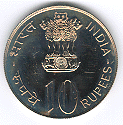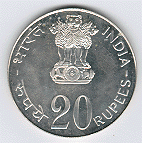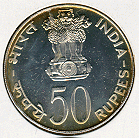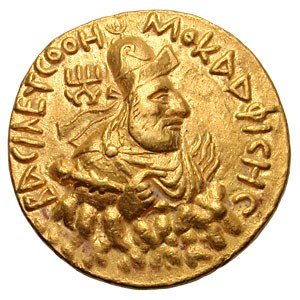EAST INDIA COMPANY COINAGE
Vasco Da Gama was the first European to reach India via sea route in 1498. By 16th century, European countries like Portugal, Spain, France, England, Netherlands and Denmark had attained considerable naval superiority and built various factories all over the world, including in India. Soon after the victory of the English over Spanish Armada (Spain was major sea power and had colonized a large part of Americas by then), some adventurous merchants of London established a company with sole purpose of obtaining goods from India and selling in Britain and other European cities, the East India company. On 31st December 1600, the charter was granted by queen Elizabeth I.
The Mughal rulers of the Indian subcontinent in 17th century had no interest in trading with Europeans. After many tries, in 1613 Emperor Jahangir allowed English to establish a factory at Surat (western part of Modern Gujrath state). Soon King of England James I sent an ambassador, Sir Thomas Roe to Jahangir’s court, who managed (presenting Jahangir with various gifts, especially the European horse-driven coach) to get permission for many more factories. English got Bombay, a fine natural harbor, as a dowry brought by Portuguese princess Catherine of Braganza, who married to Charles II, King of England, in 1668. The company slowly expanded the trade and fortune till early eighteenth century. The fall of Marathas was the the key event, which opened the doors of Indian dominance for British in the mid eighteenth century .

East India Company
1793-1818 AD
In the name of Mughal emperor Shah Alam II (frozen RY 19)
Minted at Murshidabad between 1793-1818 AD (or 1202 AH)
Gold Mohur
Weight: 12.36 gm
Reference: KM#103
Bengal was the province where British tasted fruits of their first success. In 1698 British purchased `Zamindari’ (authority to collect taxes) of the three villages of Govindpur, Sutanuti and Kalighatta (Calcutta) for 1200 rupees. Siraj-ud-Daula, the Nawab of Bengal strongly disliked British presence and their fortifications of factories. British bribed his general Mir Jafar and defeated the Nawab in Battle of Plassy in 1757. Mir Jafar treacherously killed the Nawab and later gave Zamindari of twenty four paraganas as a reward to Company. This made British the actual ruler of Bengal and soon they replaced Mir Jafar with his son-in-law Mir Kasim. Mir Kasim formed a confederacy with Nawab of Awadh, and Mughal emperor Shah Alam II to recover Bengal, but was defeated at Buxor in 1764. Clive, who rose from a post of clerk to become a Governor, was instrumental in establishing the British supremacy in Bengal. He was followed by Warren Hastings who reaped the harvest. He managed to extract a massive sum of 40,00,000 Rupees from King of Banaras and 550,000 Pounds from Begums (wives and mothers of the King/Nawab) of Awadh, making enormous profit for the East India Company. Warren Hasting took control of Awadh, Mysore, Hyderabad , Karnataka, Surat, Tanjavore kingdoms/states mostly by bribery and force. British finally took control of Delhi in 1803 and Mughal emperor Shah Alam II virtually lived as a company pensioner, thus ending the dignity of Mughal Raj completely.
Shown above is a beautiful gold coin minted at Murshidabad, Calcutta by East India Compnay. This is a machine struck gold coin popularly called Mohur or Muhar. This gold coin minted by East India Company (EIC) in Mughal style and used extensively till they introduced their own monetary system in 1835 AD. By the early 1830, the English had become the dominant power in India. The rise of British as the most dominant power after over a hundred years of turmoil, lead them to enact the Coinage Act of 1835 and for uniform coinage to be issued. Newly designed coins with the effigy of William IV on the obverse and the value on the reverse in English and Urdu, were issued in 1835. The coins from that time onwards were minted in Western style showing portraits of King/queen of England, with the legends in English. The finest example of this is shown below.
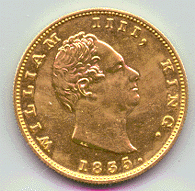
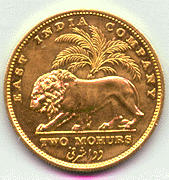
William IV
1835-1840 AD
Gold, Double Mohur
Weight: 23 gms
Minted at Bombay, Proof-Like restrike
Rare
East india company struck coins in India till 1857 when the first war of Independence (also known as Sepoy mutiny by British historians) broke. Most native rulers resented the British presence on Indian soil, the very factor brought them together and they revolted against EIC. But, British were better organized, had better resources and better trained troops. British acted swiftly, the revolt was quickly suppressed and finally whole Indian subcontinent was effectively brought under control of EIC. British politicians at that juncture decided to intervene. A bill was passed in British parliament and this resulted in the loss of EIC control over entire Indian subcontinent. In 1858 AD, just after India’s first war of Independence, all the property and powers of East India company were transferred to British crown. Queen Victoria of England was declared as queen and later Empress of India. The following section shows the coins of East India Company, which were minted during the reign of British monarchs, William IV (1835-1840 AD) and Queen Victoria (1840-1857 AD).

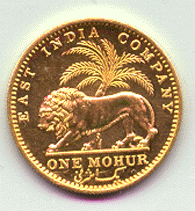
William IV
1835-1840 AD
Gold, One Mohur
Weight: 11.6 gms
Minted at Bombay, Proof-Like restrike
Scarce
Some of these coins were also minted in Proof, thus making the William’s gold coins to be one of the earliest proof gold coins of India. The double Mohur of William IV had a nice reverse, which was a symbol of Lion and a Palm tree. When Reserve Bank of India was creared, they started looking for a emblem or seal design for the bank. After a lot of research (!), it was decided that the reverse of Double Mohur, the Lion and Palm design should be used as the emblem of RBI. The last minute modification was made, introducing Tiger instead of Lion. ALL the currency notes (which are issued by RBI) of modern India has this design which originated from William’s double Mohur. Shown above are the images of proof like restrikes of these two famous gold coins, Two Mohur and one Mohur. Since these two coins have proof like finish, they are difficult to scan, nevertheless, these two are arguably THE most beautiful machine struck coins of India.
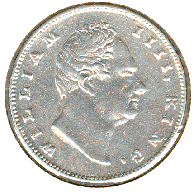
William IV
Silver Rupee
Weight: 11.66 gms
Minted at Bombay in 1835 AD
Reference: KM#450.1
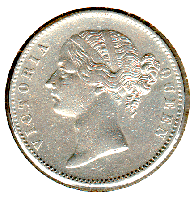
Victoria
Silver Rupee
Weight: 11.66 gms
Minted at Madras in 1840
Reference: KM#458.5
BRITISH RAJ COINAGE
Shown below are few portrait type coins of British india, popularly called Raj. The Raj coins were initially minted with mature portrait of Victoria, as queen, on obverse (an example shown below). Coins were minted in both silver (Rupees) and gold (Mohurs). Later, when she was declared as Empress of India, it was proclaimed by issuing coins in her name as Empress. Other British monarchs who succeeded her later appeared on the coins. The lower denomination in silver and copper (eg. half, quarter and 1/8th of ruppe etc.) with identical style were also minted. In gold, the Double mohur coin initiated during William IV reign was discontinued and thus during Victorian era only one Mohur coin was issued. The silver coins were minted in millions in India which were to become the mainstay of economy of entire Indian subcontinent and many neighbouring countries. They are THE MOST ABUNDANT coins of India. I have entire set in both silver and gold, so folks, please do not send me e mails, informing absence of any particular coin in EIC portrait series, on webpage.
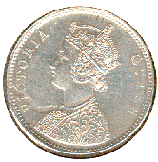
Victoria, as Queen (mature bust)
Silver Rupee
Weight: 11.66 gms
Minted at Madras in 1862
Reference: KM#473.1
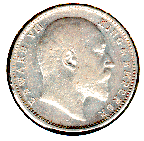
Edvard VII
Silver Rupee
Weight: 11.66 gms
Minted at Bombay in 1904
Reference: KM#492
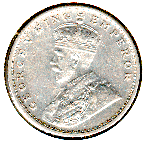
George V
Silver Rupee
Weight: 11.66 gms
Minted at Madras in 1917
Reference: KM#558.5

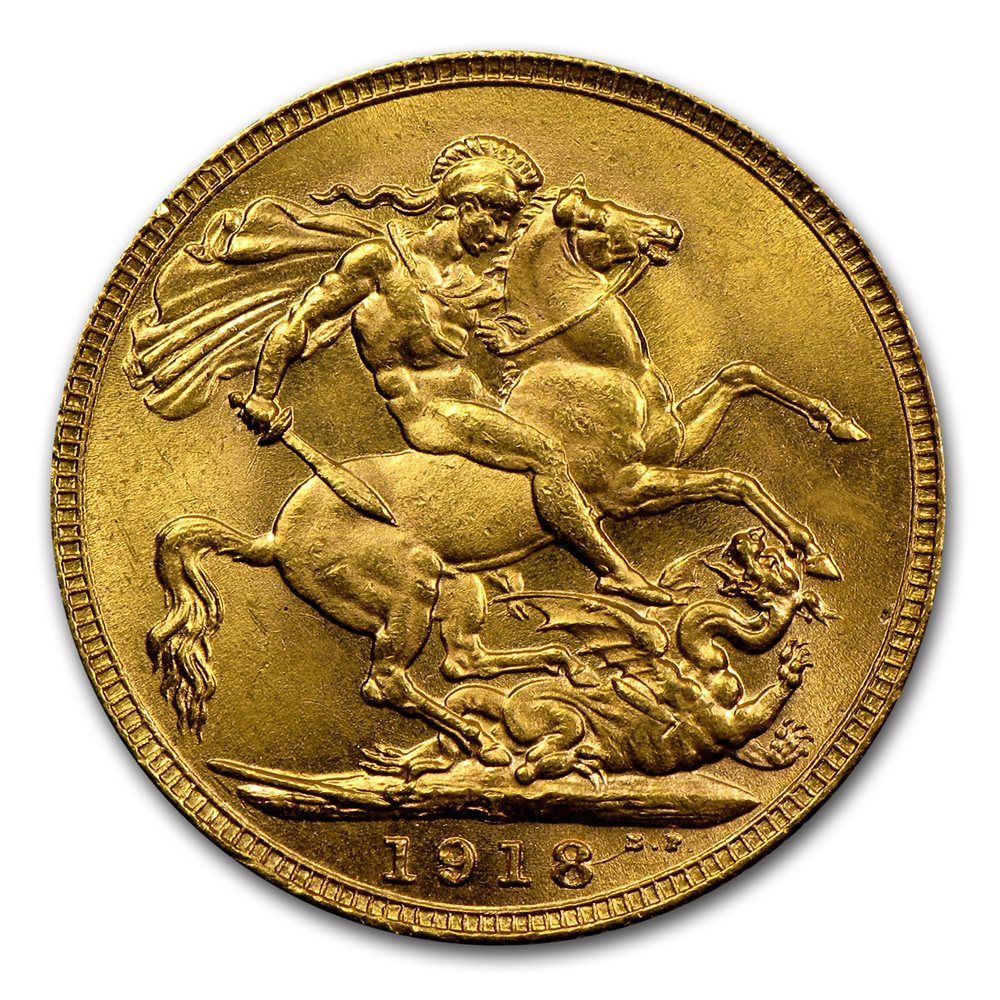
George V
Gold Sovereign
Weight: 7.98 gms
Minted at Bombay in 1918
Reference: KM#525A
COINS OF MODERN INDIA
India declared independence on 15th August 1947. India was partitioned into three parts. India, Pakistan and Bangladesh (former East pakistan). India was declared as Republic in 1950. On 15th August 1950, India introduced it’s own coinage, all of which have Ashokas (the greatest Mauryan Emperor) Lion Capital motif (described in First coinage of India). This Lion-Capital erected by Ashoka (four-lion pillar which is shown above) gleams in polished white sandstone realistically represents the artistic achievements of Indian artists and patronage of their masters, in ancient period. This Lion-Capital, erected at Sarnath (in modern Madhya Pradesh state) has become the national emblem of modern republic of India. All the coins and currency notes of modern India have this four-lion symbol on it.
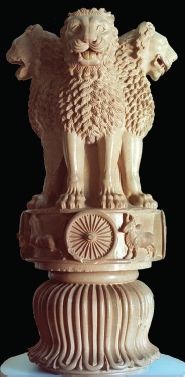
Soon India minted it’s own proof coin sets for coin collectors. The legal tender in India is the Rupee which for first 10 years, consisted of 192 pies. In 1957, India adopted a decimal monetary system where One Rupee was deemed to consist of 100 Paise (singular Paisa). The modern Indian coinage are managed by the Government of India (NOT Reserve bank of India, which manage the currency notes). Coins are issued in denominations of Ten Paise, Twenty Five Paise, Fifty Paisa, Rupee One, Rupees Two and Rupees Five. All currency notes have emblem of Reserve Bank of India, which was chosen after great deliberations. Large number of seals, medals and coins were examined for the emblem design. The East India Company Double Mohur, a large gold coin, the reverse of which had a picture of the Lion and Palm Tree, was chosen as emblem. Although, the picture was modified by replacing the lion with the tiger, the latter being regarded as the more characteristic animal of India! This RBI emblem which was adapted during British rule was retained even after independence and still adorn all currency notes of modern India. The image of the Double Mohur of East India Company coin which depicts the Lion and palm tree picture from where the modern emblem is originated, is shown above and below.
Shown here are some of the coins of the modern India. Most common varieties are not included, but the coins of higher denomination (which are rarely seen in circulation) are shown in this webpage. The coins displayed in this section are proof coins.
